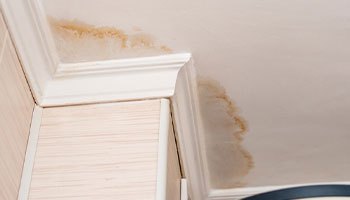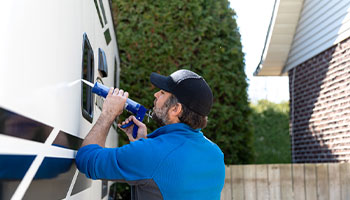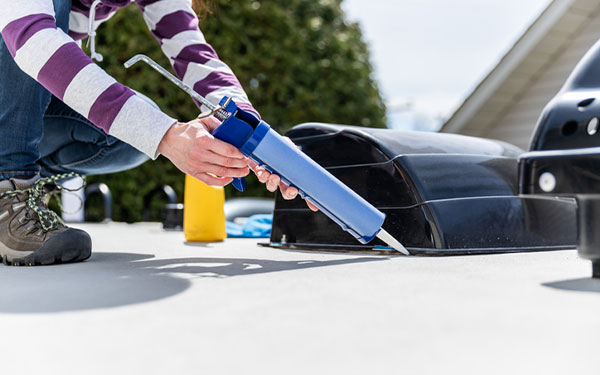If there is a way into your RV, water will find it. If left untreated, water leaks can result in extensive water damage that is often expensive to repair. Because water damage occurs over time, it is essential to understand what signs to look out for before any lasting damage occurs.
What is RV Water Damage?
Water damage is when water finds its way into places where it doesn’t belong, such as walls, cabinets, or ceilings. When these normally dry areas get wet, they begin to deteriorate. While often caused by water leaks, finding a leak doesn’t necessarily mean your RV has water damage. If you can catch a leak early on, you can repair it before any lasting harm transpires.
Because RVs travel through all types of weather, you may find yourself dealing with water issues even if you take excellent care of your rig. Unfortunately, this also means that no RV is immune to potential water damage. While your make and model may play a role, the main factor is often age. Over time, seals and seams begin to weaken, making it easier for water to enter where it shouldn’t.
Water damage can lead to structural damage, but it also promotes mold growth. When water doesn’t effectively dry out, mold can begin forming within just a few days. Mold can grow on most surfaces within your RV and is a health risk to anyone exposed.
How to Identify Water Damage
A good rule of thumb is to inspect your RV twice a year for any water issues. We recommend checking your RV at the start of your RV season, followed by another inspection at the end. Here are a few common signs to look out for when conducting a review.
Delamination
Delamination is when the fiberglass or upper coat layer on an RV begins to separate itself from any backing material. In most RVs, the backing material is often lightweight plywood. Delamination is one of the most tell-tale signs of water damage in RVs, as moisture speeds up the process.
Key signs to look out for are material separation, bubbled areas, and small cracks.
Look for Soft Spots
RVs are sturdy vehicles that can handle pressure, so yours shouldn’t have any soft spots. If you find any weak spots on your walls, floors, or ceiling, it is likely due to water.
When looking for soft spots, begin in the areas where you’d expect to find water (bathroom, sink, etc.), then slowly expand outward. What is important is that you be thorough in your search, running your fingers along all surfaces to catch any affected areas.
Mildew Smell or Mold
When checking for water issues, sometimes you must follow your nose.
Unfortunately for RVers, water damage isn’t always visible. So, if you encounter a musty smell coming from the inside of your rig, it could mean that mold is growing inside.
Discoloration

Discoloration is one of the most obvious signs of water damage. As surfaces become exposed to water, they will often begin to discolor or stain. At first, any discoloration will appear as a brownish color. Over time, the color will slowly turn black as mold begins to set in place. By following the trail of discoloration, you may be able to identify the source of the problem.
How to Prevent Water Damage
When traveling down bumpy roads, RVs do a lot of flexing and movements that can separate seals and seams. Therefore, the best way to prevent damage is to frequently inspect, seal, and reseal areas.

Consider incorporating roof checks on your pre-departure checklist to catch any damage that may have occurred while parked from tree branches or falling objects. If your RV sits through heavy weather, it is also recommended to inspect your rig before continuing to adventure.
Remember, a water leak does not necessarily mean that your RV has water damage, but issues will develop if left untreated. So, by performing routine checks, you’ll be able to catch leaks early on and avoid any problems down the road.
Carrying tools and being comfortable doing minor repairs on the road will also help prevent any water problems. We recommend having RV-specific sealants on the road with you in your tool bag to stop any leaks before they cause any harm. Certain materials require specific sealants, so always make sure you’re using the right products for your RV.
Stay Protected with Specialty RV Insurance
Keeping your RV protected begins with carrying RV insurance. Depending on your coverage, you may be covered against any water issues. As with most insurance, coverage can vary depending on location and carrier. To learn more about how to protect your home on wheels, give our RV insurance specialists a call at (866) 501-7335.
The information in this article is obtained from various sources and is offered for educational purposes. Furthermore, it should not replace manuals or instructions provided by the manufacturer or the advice of a qualified professional. No warranty or appropriateness for a specific purpose is expressed or implied.
